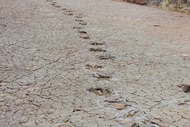Create a free profile to get unlimited access to exclusive videos, sweepstakes, and more!
Does the Earth have a Mysterious 27.5 Million Year Catastrophe Cycle?
It looks like it; fortunately we've got some time before the next pulse.

Writer and director Thunder Levin (the twisted mind behind the Sharknado franchise) has an obvious penchant for smashing seemingly unrelated threats together. He took that philosophy to the ultimate extreme in 2017’s Geo-Disaster (streaming now on Peacock) by putting the Earth in the path of every major natural disaster imaginable.
When a chunk of dark matter smashes into the planet it triggers a series of earthquakes, volcanoes, and tornadoes. It’s the natural disaster to end all disasters, and if it’s ever going to happen it will probably be about 20 million years from now according to a study published in the journal Geosciences Frontier.
Extinctions and Natural Disasters Have a 27.5 Million Year Cycle
Natural disasters are famously hard to predict and prepare for. The systems that determine when a volcano goes off or an earthquake shakes things up are so complex that we struggle to know when anything is about to happen with more than a few minutes of notice. A growing body of research suggests, however, that there is a regular cycle of geological activity leading to increased disasters and extinctions every 27.5 million years.
A team of researchers led by Michael Rampino analyzed 89 geological events including extinctions in the oceans and on land, ocean-anoxic events, volcanic eruptions, major sea level changes, and intraplate magnetism, over the last 260 million years. When lined up in a row, researchers found 10 total clusters at an average interval of 27.5 million years. The study follows up on Rampino’s previous work, including a 2020 study which found an extinction cycle at essentially the same frequency. An unrelated 2018 study by Muller and Dutkiewicz found a similar frequency in the atmospheric carbon cycle occurring roughly every 26 million years.
One interpretation of the data is that natural disasters can be predicted with at least a low degree of definition. We can’t say with any certainty that a disaster will happen on a given day or even in a given year, but it might be true that the probability of major disasters increases and decreases at regular intervals. With each additional study pointing to more or less the same conclusion, the evidence for some sort of geological cycle at roughly 27.5 million years grows stronger. What is driving that cycle remains a mystery, though researchers suggest it might be related to internal geophysical processes, the motion of the Earth through space, or some combination of the two.
“These cyclic pulses of tectonics and climate change may be the result of geophysical processes related to the dynamics of plate tectonics and mantle plumes,” the study authors wrote. “Or might alternatively be paced by astronomical cycles associated with the Earth’s motions in the Solar System and the Galaxy.” If the geological disaster pulse keeps pace, we’ll know about it when the next pulse happens about 20 million years from now.
While we’re waiting for the next wave of extinction-level disasters to occur, check out Geo-Disaster streaming now on Peacock!



























